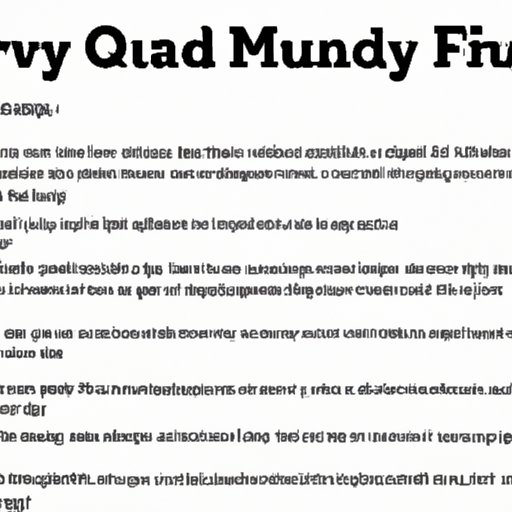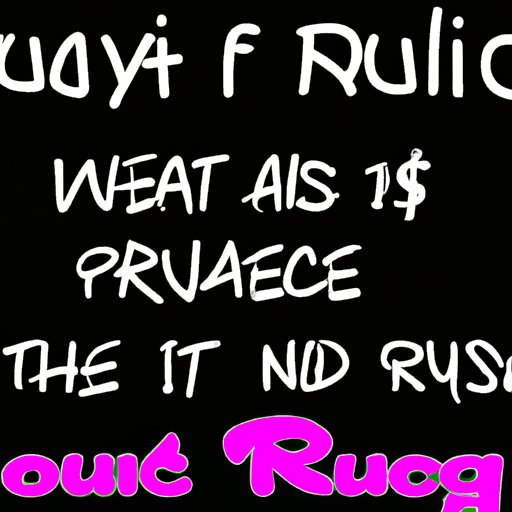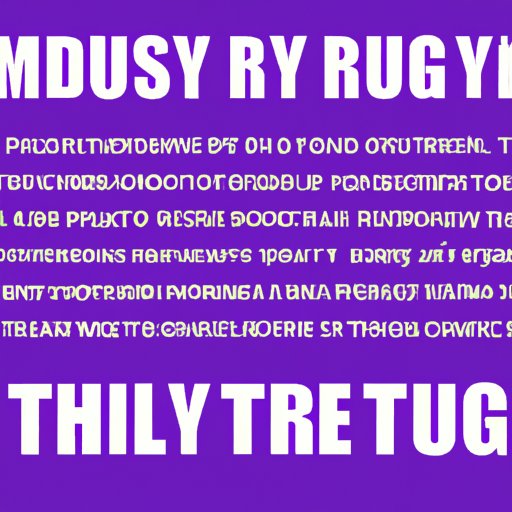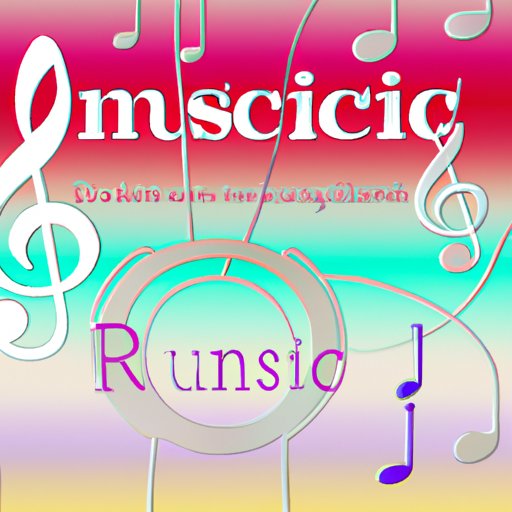Introduction
Royalty free music is a type of music license that grants users unlimited access to music tracks for a one-time fee. This type of license allows users to use the music in their projects without paying any additional royalties or fees. It is a popular option for those who are looking for cost-effective music that can be used for multiple purposes. This article will explore the benefits of royalty free music, how to find quality music, how to use it in projects, the pros and cons, legalities, and 10 best sources for royalty free music.
Exploring the Benefits of Royalty Free Music
There are several benefits to using royalty free music in your projects. First, it is a cost-effective option for those who need music for their projects but don’t want to pay for expensive licenses. According to a survey conducted by the Music Business Association, “The majority (63%) of respondents said they have made use of royalty free music in their work.” This demonstrates that many people are taking advantage of this cost-effective music option.
Second, royalty free music is also highly accessible. Most royalty free music libraries offer a wide range of genres and styles, making it easy to find the perfect track for your project. Additionally, the music is usually available in multiple formats, such as MP3 and WAV, so you can easily download it and use it in your projects.
Finally, royalty free music is extremely versatile. It can be used in a variety of projects, including films, television shows, video games, podcasts, and more. Additionally, it can be used for both commercial and non-commercial purposes, making it a great option for businesses, artists, and content creators alike.

A Guide to Finding Quality Royalty Free Music
Finding quality royalty free music can be a challenge, but with the right tips and tricks, it doesn’t have to be. Here are a few things to keep in mind when searching for royalty free music.
1. Know Your Genres: Before you start searching for music, it’s important to know what genres you’re looking for. Different royalty free music libraries offer different genres, so it’s important to narrow down your search before you start browsing.
2. Understand Licensing Requirements: Each royalty free music library has its own licensing requirements, so it’s important to familiarize yourself with them before you purchase any music. Make sure to read through the terms and conditions carefully to ensure that you understand the rights and restrictions associated with the music.
3. Research Reputable Companies: When it comes to finding quality royalty free music, it’s important to research reputable companies. Look for companies that have been in business for a while and have a good reputation. Also, make sure to read customer reviews and ratings to get an idea of the quality of the music.

How to Use Royalty Free Music in Your Projects
Once you’ve found the perfect royalty free music for your project, it’s time to start incorporating it into your content. Here are a few tips on how to do just that.
1. Incorporate Music into Content: The first step is to incorporate the music into your content. You can do this by adding it to videos, podcasts, websites, and more. It’s important to make sure that the music fits with the tone and style of your project.
2. Utilize the Right Platforms: Depending on the type of project you’re working on, you may need to utilize different platforms to incorporate the music. For example, if you’re creating a video, you may need to use a video editing software. If you’re creating a podcast, you may need to use a podcast hosting platform.
3. Make Sure You Have the Rights: Finally, it’s important to make sure that you have the rights to use the music in your project. Most royalty free music licenses require that you credit the artist or company that owns the music, so make sure to include that information in your project.
The Pros and Cons of Royalty Free Music
Royalty free music has its advantages and disadvantages. Here are some of the pros and cons of using royalty free music.
Pros:
- Cost-Effective: Royalty free music is a cost-effective option for those who need music for their projects.
- Accessibility: Royalty free music is highly accessible, with a wide range of genres and styles available.
- Versatility: Royalty free music can be used in a variety of projects, including films, television shows, video games, podcasts, and more.
Cons:
- Limited Copyright Protection: Although royalty free music is generally cheaper than other types of music licenses, it offers limited copyright protection.
- Potential for Low Quality Music: There is always the potential for low quality music when using royalty free music.
- Issues with Licensing: Understanding the licensing requirements for royalty free music can be confusing and difficult.

Understanding the Legalities of Royalty Free Music
When it comes to using royalty free music, there are several legal considerations to keep in mind. Here are a few of the most important legalities to understand.
Copyright Laws: It’s important to understand copyright laws when it comes to using royalty free music. In general, copyrighted works cannot be used without permission from the owner. Therefore, it’s important to make sure that you have the proper permissions before using any music.
Licensing Agreements: Most royalty free music libraries require users to sign a licensing agreement before they can use the music. These agreements usually outline the rights and restrictions associated with the music, so it’s important to read through them carefully before signing.
Permissions: Finally, it’s important to make sure that you have the proper permissions when using royalty free music. This includes obtaining the rights to use the music in your project, as well as crediting the artist or company that owns the music.
10 Best Sources for Royalty Free Music
Now that you know the basics of royalty free music, it’s time to start looking for the perfect track for your project. Here are 10 of the best sources for royalty free music.
- AudioJungle: AudioJungle is a popular source for royalty free music, offering a wide range of genres and styles.
- Bensound: Bensound is another great source for royalty free music, offering a selection of free and premium tracks.
- Envato Elements: Envato Elements is a subscription service that provides access to millions of royalty free music tracks.
- Jamendo: Jamendo is a great source for free and affordable royalty free music, with thousands of tracks to choose from.
- Pond5: Pond5 is a stock media marketplace that offers a selection of royalty free music tracks.
- Free Music Archive: The Free Music Archive is a great source for free and royalty free music, with a wide selection of genres and styles.
- YouTube Audio Library: The YouTube Audio Library is a great source for free royalty free music, offering a selection of tracks from various genres.
- Incompetech: Incompetech is a great source for free and royalty free music, offering a variety of genres and styles.
- ccMixter: ccMixter is a community-driven source for free and royalty free music, with a selection of tracks from various genres.
- SoundCloud: SoundCloud is a popular source for royalty free music, offering a wide selection of tracks from various genres.

Crafting a Unique Soundtrack with Royalty Free Music
Once you’ve found the perfect royalty free music for your project, it’s time to start crafting a unique soundtrack. Here are a few tips on how to do just that.
1. Create an Original Soundscape: Start by creating an original soundscape for your project. Think about the mood, tone, and atmosphere that you want to create, and then look for tracks that complement it. This will help you craft a unique soundtrack that perfectly captures the essence of your project.
2. Find Inspiration: Once you’ve created a soundscape, it’s time to find inspiration. Listen to other soundtracks and get an idea of what works and what doesn’t. This will help you come up with new ideas and refine your soundtrack.
3. Leverage Technology: Finally, leverage technology to help you craft your soundtrack. There are a number of tools and apps that can help you mix, edit, and master your tracks, giving you full control over the sound.
Conclusion
In conclusion, royalty free music is a great option for those who need music for their projects but don’t want to pay for expensive licenses. It is cost-effective, highly accessible, and extremely versatile. Additionally, it can be used in a variety of projects, including films, television shows, video games, podcasts, and more. However, it is important to understand the legalities of royalty free music, including copyright laws, licensing agreements, and permissions. Finally, there are a number of sources for royalty free music, ranging from free to premium. With the right tips and tricks, you can craft a unique soundtrack for your project that perfectly captures the essence of your project.
(Note: Is this article not meeting your expectations? Do you have knowledge or insights to share? Unlock new opportunities and expand your reach by joining our authors team. Click Registration to join us and share your expertise with our readers.)
